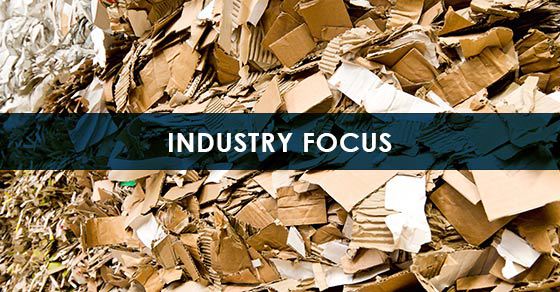The coronavirus pandemic has touched every industry imaginable in ways most of us would never have thought possible. In most cases, the effects have been negative, save for a lucky few that saw positive changes, and fewer still that saw changes on both sides of the spectrum.
One sector where changes took place across the board was the pulp and paper industry. The pandemic has affected pulp and paper to an unprecedented extent, accelerating existing trends and turning other parts of the industry upside down. Many industry experts think the changes the coronavirus brought to pulp and paper are here to stay.
As a leader in custom equipment for processing pulp and paper byproducts, as well as bulk solids handling equipment, we’re highlighting what’s changed, and what could be ahead for pulp and paper.
Pulp and Paper Industry Trends
Covid-19 brought major swings in demand to the different sub-sectors of the pulp and paper industry, dropping the bottom out of some markets, while bolstering demand in others.
Sanitary Paper Products Surge
It’s probably safe to say that no one anticipated how strikingly a global pandemic could impact demand for paper products associated with cleaning and hygiene. The increased awareness of germ spread and heightened sanitation practices at every level of society saw both businesses and consumers scrambling to stock up. From scuffles over toilet paper to shortages of paper towels, tissues, and disposable wipes, stores couldn’t keep these products in stock.
And while lean manufacturing practices were partly to blame for shortages, the market still saw a deluge in demand unlike anything before.
Packaging Products
Online shopping was trending in a positive direction before the pandemic, with conveniences like meal kit and grocery delivery services already on the rise, but forced lockdowns and cautionary sentiments led to a significant spike in e-commerce, with consumers doing as much of their shopping online as possible. This garnered a major boost in the demand for cardboard boxes.
Less Recycling = More Virgin Production
While packaging products surged, commercial and industrial demand for paper products declined as many businesses closed or were forced to work at reduced levels. This reduction in demand created a new challenge for the industry as sources of commercial paper waste – an important resource for manufacturing some products – plunged. And despite urges to consumers to ramp up their recycling efforts at home, proper recycling still remains a significant challenge.
Printing & Writing Way Down
While packaging and other paper products surged, some sub-sectors of the industry were not so fortunate. Perhaps nowhere was damage from the pandemic more evident than in the printing and writing (P&W) space.
Widespread work-from-home patterns, combined with the switch to online learning and shopping was a devastating blow for the sector already struggling in the digital age, according to Forest2Market. Numerous plants were shuttered, some permanently, while others were converted to produce more in-demand products.
Looking Ahead at Pulp & Paper
The pandemic has made clear just how integral the pulp and paper industry is to our everyday lives. And while a return to normalcy is likely to somewhat rebalance the market, some of these trends were already in progress; the coronavirus simply accelerated their pace, leading many to wonder if some of the results will stick around. Other trends emphasized what we already knew and have served to underscore already-important initiatives.
Experts are unsure of what to expect in the coming years, but many see the need for better recycling as a change that won’t go away, even despite temporary derailment.
Need for Improved Recycling
The changes in demand brought on by the pandemic have highlighted the need for increased and improved recycling.
The drop in commercial sources of secondary fibers, paired with the rise in contaminated consumer recyclables unfit for processing has been a significant struggle for the recycling industry. Many MRFs (Material Recovery Facilities) that rely on used fiber feedstocks have been shut down, consolidated, or forced to retool their operations for virgin products.
On the back of China’s decision to stop accepting such wastes, the struggle further emphasizes the need for a better domestic recycling system. This need is evident in the US EPA’s National Recycling Strategy draft, through which, among other objectives, the agency hopes to reduce the amount of contamination present in recycling.
But recycling doesn’t have to exclusively mean processing used paper into other similar paper products; there are plenty of beneficial reuse opportunities for paper sludge and other byproducts, including pet beddings and litters, as well as soil amendment and fertilizer products. FEECO has worked with several companies in our Innovation Center to develop commercial-scale processes around their beneficial reuse products.
In addition to stressing the need for better recycling, the pandemic also accentuated the already well-accepted notion that we need to find alternatives to plastic.
Move Away from Plastic
As managing the virus became priority number one, some sustainability efforts temporarily took a backseat. Most notably, the virus caused a surge in plastic waste due to increased single-use plastics for everything from takeout containers to PPE.
The surge in plastic waste has lit a fire under a movement already underway, and paper products are a strong contender for replacing plastics.
Conclusion
From the development of processes for beneficial paper sludge reuse applications, to material handling equipment for wood chips, and rotary dryers for paper sludge, FEECO has been, and continues to remain an important resource for the paper industry.
For more information on our custom equipment, testing and process development services, or our extensive parts and service program, contact us today!


